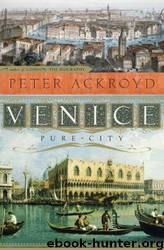Venice: Pure City by Peter Ackroyd

Author:Peter Ackroyd
Language: eng
Format: mobi
Tags: Europe, Sociology, Italy, Customs & Traditions, General, Venice (Italy), History, Social Science
ISBN: 9780385531528
Publisher: Random House of Canada
Published: 2010-11-02T20:22:59+00:00
20
Iustitia
On one of the three exposed corners of the ducal palace, there is a sculpture concerning the judgement of Solomon. On the west façade of the palace is the figure of Iustitia, with the sword of justice upright in her hand; here also is the word “Venecia.” Venice and Justice have been combined in one eternal image, with the inscription “Strong and just, enthroned I put the furies of the sea beneath my feet.” Above the Porta della Carta, in the same complex of public buildings, is enthroned the virgin image of Venetia and Iustitia with sword and scales. The crowning figures of the palace are also those of Iustitia. The justice of Venice is one of the myths of Venice. It is deemed to be ancient. It is deemed to be divinely inspired. It is related, in ultimate form, to the judicial salvation of humankind.
The actual nature of Venetian law is less glorious, but perhaps more interesting. As in all aspects of the Venetian polity, it was of mixed inheritance. Elements of it came from Roman jurisprudence, and from Byzantine legislation. Other elements were taken from the Lombard and Frankish codes. Having no firm territorial foundation, Venice was forced to adapt or borrow the traditions of other peoples. It could be said that the Venetians created a patchwork coalition of various legal principles, flexible and accommodating for any circumstances. Venetian law was, above all else, efficient. A nation all at sea must first save itself.
The first code of jurisprudence was promulgated at the close of the twelfth century, and the laws were collected in the following century within the pages of five great books. The majority of statutes, as might be expected in a city of merchants, dealt with matters of wealth and property. Commercial law was the most voluminous. The five books might be said, in fact, to embody a mercantile attitude towards law. Despite the reverence for the customary image of Justice, the practice of the Venetians seems to have been largely empirical and pragmatic. The laws were often acknowledgements of what already existed in practice. Customary law, unwritten and on occasions anecdotal, seems to have been pre-eminent. It was even declared that custom might override the written law. This is in part evidence of the merchant spirit, distrusting legal niceties and quibbles. The offender must pay for dishonour done to God, and disrespect shown to the city. These were the important matters.
It was often said that Venetians were more fond of talking than of doing. Certainly it is true that no other city-state produced so much legislation. The contents of these laws are sometimes confusing, inconsistent and contradictory. They were passed and then not enacted. They were issued, or reissued, when the very same laws were already on the statute books. The leaders of Venice legislated too much. There is an air of fantasy, or of unreality, about their search for legal formulae. Some of the great council believed or thought that they remembered a certain law.
Download
This site does not store any files on its server. We only index and link to content provided by other sites. Please contact the content providers to delete copyright contents if any and email us, we'll remove relevant links or contents immediately.
Spell It Out by David Crystal(36082)
Underground: A Human History of the Worlds Beneath Our Feet by Will Hunt(12049)
A Year in the Merde by Stephen Clarke(5366)
Venice by Jan Morris(2545)
Claridge's: The Cookbook by Nail Martyn & Erickson Meredith(2379)
My Paris Kitchen: Recipes and Stories by Lebovitz David(2269)
A TIME OF GIFTS by Patrick Leigh Fermor(2173)
The Plantagenets by Dan Jones(2058)
Welcome to the Goddamn Ice Cube by Blair Braverman(2013)
The Finnish Way by Katja Pantzar(1958)
Top 10 Prague (EYEWITNESS TOP 10 TRAVEL GUIDES) by DK(1953)
From Russia with Lunch by David Smiedt(1947)
Bang Poland: How To Make Love With Polish Girls In Poland by Roosh V(1944)
The Isle of Mull by Terry Marsh(1913)
A TIME TO KEEP SILENCE by Patrick Leigh Fermor(1880)
Rick Steves London 2018 by Rick Steves & Gene Openshaw(1838)
Insight Guides Experience Tokyo by Insight Guides(1832)
A Taste of Paris by David Downie(1830)
Merde in Europe by Stephen Clarke(1739)
